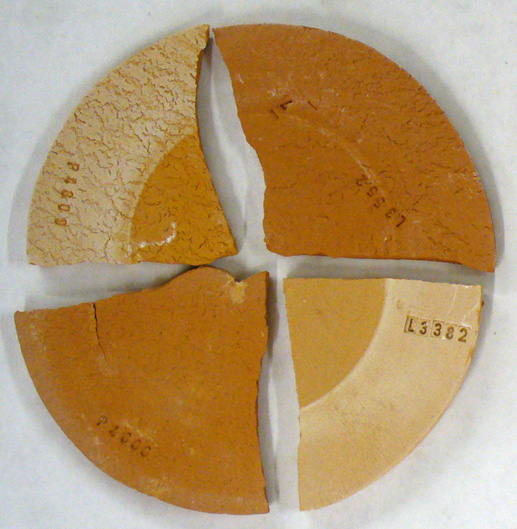| Monthly Tech-Tip | No tracking! No ads! |
Barium Carbonate in Clay Bodies
MSDS sheets indicate that barium (CAS: 7440-39-3) is poison and toxic if ingested. MSDS sheets also claim that barium is an irritant for inhalation and skin contact. Excessive amounts can cause violent diarrhea, convulsive tremors, and muscular paralysis. Barium is known to affect the heart and nervous system.
In ceramics, barium is most commonly inhaled as a fine dust or absorbed through cuts or lesions on the hands of people who handle compounds containing the material. However, some authorities quote inhalation exposure limits that are less restrictive than those for silica (e.g. ACGIH lists a Threshold Limit Value (TLV) at 0.5 mg/cubic meter for barium while quartz is 0.05). OSHA, on the other hand, lists quartz as 10.0 and barium as 0.5.
Almost all raw clay materials (including kaolins) contain soluble impurities (i.e. iron-stained calcium/magnesium sulphates). When a raw piece of clay is dried, these impurities come to the surface with the water as it evaporates. During firing, this leaves an unsightly glassy discoloration on the surface (in some cases even a glaze-like surface). In structural products, this is called "efflorescence". Such surfaces are highly prized in sculpture bodies because they highlight textures and contours. Of course, in functional pottery and structural products, these salts are not wanted. Even after a clay is fired, the salts can come to the surface if the clay is non-vitreous and is rewetted often (as is the case with red terra cotta brick). These surface deposits can affect melting patterns of overlying glaze layers. Fused solubles on the surface can also stick ware together or to kiln shelves and can seal the surface, causing premature bloating during firing.
Clay supply companies commonly add barium carbonate to clay bodies and raw products (0.1-0.6%) to mitigate this problem. The barium chemically reacts with the sulphates to precipitate insoluble products. In the reaction, very slightly soluble barium carbonate and soluble calcium sulphate convert to insoluble barium sulphate and calcium carbonate. Thus, both remain within the body and do not concentrate on the surface during drying. It is possible to measure the amount of solubles in a clay body and calculate the minimum amount of barium needed to precipitate them. However, in practical term,s this does not work because different types and even shipments of barium vary in their effectiveness and the natural salt content within the clays varies even more. If the fired surface is monitored closely companies can continuoiusly adjust to use just enough barium to precipitate all the soluble, but no more (barium is expensive and industry obviously does not want to use more than is necessary).
The presence of barium in clay bodies is sometimes thought to be a health hazard for hypersensitive people. But it is difficult to even demonstrate its solubility, and therefore bioavailability, in a simple lab experiment (MSDS sheets may even list it as insoluble). However, it does precipitate the dissolved calcium and magnesium salts in the clays, which proves that part of it is dissolving. In addition lab tests to deduce barium carbonate content in aged pugged clay bodies have shown a much lesser quantity of unreacted barium than the slight solubility suggests is possible. An MSDS from BassTech International classifies barium as moderately toxic on inhalation, non-toxic on contact or skin absorption, an eye irritant and toxic if ingested at 57mg per kg of body weight (this would be over 1 kg of pugged clay containing the highest proportion of barium normally used). If there is a hazard, then the most likely would be breathing in the dust and swallowing part of it. Obviously, it would be impossible to breathe in enough to be harmful.
Leaching Hazard When Used in Clay Bodies?
The practice of adding barium to clay bodies is questioned by some as a leaching hazard in functional ware made from the clay. However, one must consider:
- The barium is distributed within the clay matrix, only a very tiny fraction presents itself at the surface.
- The barium reacts with comparatively abundant fluxes and silica (and is a flux itself) in vitreous clay bodies to form insoluble silicate glasses within.
- Functional ware is covered with glaze, thereby isolating the clay surface from food surfaces.
- When calcium and magnesium sulphates are available, the soluble portion of the barium converts to insoluble and harmless barium sulphate.
- Barium carbonate makes it possible to make bodies using native natural coarser-grained materials (which are inherently safer because they contain fewer respirable quartz particles.
The US Food and Drug Administration does not have a leaching requirement for barium. However, the US EPA has a standard for drinking water of 2 mg/liter or less. This standard was set to protect the population most at risk for heart effects - adult men. Testing can be done at Elemental Research Lab, 309-267 West Esplanade, North Vancouver, B.C. Canada V7M 1A5 604-985-0445 (they test many metals). Also at Kirby Health Center Lab, 71 North Franklin Street, Wilkes-Barre, PA 18701 717-822-4278.
| By Tony Hansen Follow me on        |  |
Related Information
A typical DFAC drying disk of an iron stoneware clay

This picture has its own page with more detail, click here to see it.
The center portion was of this DFAC test disk was covered and so it lagged behind during drying, setting up stresses that caused the disk to crack. This test is such that most pottery clays will exhibit a crack. The severity of the crack becomes a way to compare drying performances. Notice the test also shows soluble salts concentrating around the outer perimeter, they migrated there from the center section because it was not exposed to the air.
Soluble salts on cone 04 terra cotta clay bodies

This picture has its own page with more detail, click here to see it.
Low temperature clays are far more likely to have this issue. And if present, it is more likely to be unsightly. The salt-free specimens have 0.35% added barium carbonate.
The magic of a small barium carbonate addition to a clay body

This picture has its own page with more detail, click here to see it.
Two bisqued terracotta mugs demonstrate efflorescence. The clay on the right has 0.35% added barium carbonate (it precipitated the natural soluble salts dissolved in the clay and prevented them from coming to the surface with the water and being left there during drying). The process is called efflorescence and is the bane of the brick and terra cotta tile industries. The one on the left is the natural clay. The unsightly appearance is fingerprints from handling the piece in the leather-hard state, the salts have concentrated in these areas (the other piece was also handled).
Cone 10R stoneware clay with and without barium carbonate

This picture has its own page with more detail, click here to see it.
0.35% barium added to the one of the left makes the amazing difference on the bases of these two stoneware mugs. The slightly soluble barium precipitates the soluble sulphates in the body, leaving them insoluble within the matrix. Notice that not only has the brown glassy scum at the edges been removed but the whole body surface is actually less vitreous.
How bad can efflorescence on terra cotta be?

This picture has its own page with more detail, click here to see it.
Like this! This terra cotta clay matures to good strength around 1950F. Notice how the soluble salts have concentrated on the outer and most visible surface. The piece was dried upside down so, of course, all the water had to escape through that route. A complicating factor is how handling of the piece at the leather hard stage has made it even more unsightly. This problem is common in many terra cotta materials but can also surface in others. A tiny addition of barium carbonate can precipitate the salts inside the clay matrix so they do not come to the surface on drying.
Links
| Materials |
Barium Carbonate
A pure source of BaO for ceramic glazes. This is 77% BaO and has an LOI of 23% (lost at CO2 on firing). |
| Materials |
Barium Sulfate
|
| Oxides | BaO - Barium Oxide, Baria |
| Hazards |
Barium Carbonate in Glazes
|
| Hazards |
BARIUM and COMPOUNDS Toxicology
|
| Hazards |
Understanding Acronyms on MSDS's
Understanding the meaning and purpose of acronyms used on materials safety data sheets for ceramic minerals and materials |
| Minerals |
Gypsum
Gypsum is hydrated calcium sulphate, CaSO4 2H2O. It is the crystalline mineral from which plaster is |
| Glossary |
Efflorescence
A common problem with dry and fired ceramic. It is evident by the presence of a light or dark colored scum on the dry or fired surface. |
| Glossary |
Sulfates
Soluble sulfates in clay produce efflorescence, an unsightly scum that mars the fired surface of structural and functional ceramic products. |
| Articles |
Soluble Salts in Minerals: Detailed Overview
There are a wide range of soluble materials that can be in clay, this article enumerates them, provides procedures on identifying and measuring them and outlines what to do about the problem. |
Got a Question?
Buy me a coffee and we can talk

https://digitalfire.com, All Rights Reserved
Privacy Policy
